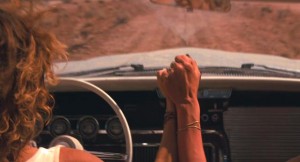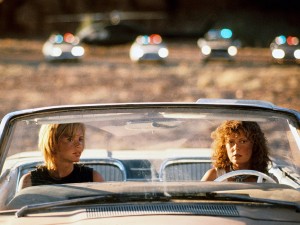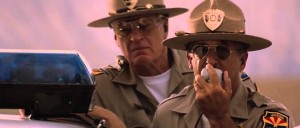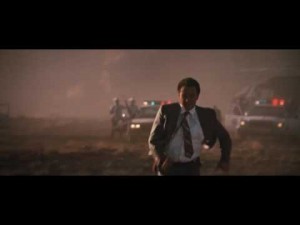Brett Wineland
THFM 1710
April 20th, 2017
Thelma and Louise
Thelma and Louise (1991) can easily be argued as the last great women adventure film of our time. The film itself has placed a historical foothold in cinema and has been both referenced and copied in many films since its release. The film follows house wife Thelma (Geena Davis), and friend Louise (Susan Sarandon) as they flee in a ‘66 Thunderbird to Mexico after a rape altercation that causes Louise to kill a man in cold blood. For the purposes of this paper I will be dissecting the final scene in the film involving the two women deciding to take their own lives in a very dramatic way instead of turning themselves into law enforcement.
The scene in question involves a police car and helicopter chase. As the two women abruptly reach both the figurative and literal “end of the road”, the helicopter carrying the lead FBI agent tasked with apprehending the women appears from the canyon below. The women swerve the car around and race back the way they came only to be cornered by the police cars holding a stand-off. Everyone loads their weapons as an officer tries to convince the women to surrender over loud speaker. To much surprise, Thelma convinces Louise that getting caught isn’t the right choice to make and that they should “keep going”. Recognizing what she means, Louise kisses Thelma before pushing the pedal to the floor as the car rushes towards the canyon cliff. The two woman hold hands as the car flies off the cliff and the film fades to WHITE.
The color of the film is very iconic in its portrayal of the women and environment of the film. The mexico desert is painted as this vast open area full of brown, tan, and grey. It symbolizes new beginnings for the women. The thunderbird that they drive is powder blue and contrasts well with the desert. At this point in the film the girls are both wearing cut off shirts with blue jeans which shows their solidarity; however, Thelma is wearing a white shirt while Louise is wearing a black shirt. To me this symbolizes the light and darkness in the characters that contrasts well when it’s time for Thelma to make the final decision to take their own lives. The other color that is very important to the film is the filmmakers decision to fade to white instead of black. This is a very clear and conscious choice on their part. The “fade to black” is a common choice in film and is a nice way to show the passage of time or to end a scene/film with a sense of closure. A fade to white is very uncommon and to me adds a sense of ambiguity which is very proper for this story and how Thelma chooses her words as “let’s keep going” instead of “let’s end this right now”.
The blocking and framing of the scene plays out in a very satisfying way. Above you can see that I included several screen grabs from the film that really tie the narrative together. The first being a medium close up shot of the two women in the car with the red and blues on behind them showing their impending doom lurking from behind. The framing of this shot shows very shallow focus which adds depth to our main characters while simultaneously showing their apprehension to look back. The only part that is important about those cars in this shot is the fact that their lights are on which means they are ready to take these women down. The next shot that is very important to me is one that I was unable to find a screenshot for. It is of the two women shot from behind as they look over the edge of the road into the wide canyon below. This shot serves two main purposes. It shows that this is indeed the end of the road for them and the only way to continue now is to turn back. The shot also shows the helicopter rising up from below which adds more danger to the women and also doesn’t allow them to make a more rational decision or give them more time to think. After turning back and making the decision to end it all the girls drive off and the next frame is of the FBI agent chasing after them in a medium shot. This shot shows that he now realizes what they intend to do and gives us a look into his character as he wants to bring them to justice but doesn’t want them to die. Just then the shot changes to the two women embracing hands in a very interesting close up as the vehicle speeds away. This shot is the culmination of their friendship and shows that even in the end they are there for eachother. The last and most iconic shot of the film is a low angle wide shot of the car flying off the edge of the cliff with one of the hub caps rolling along behind it. This shot along with the fade to white are what make this movie and this scene so memorable.
All in all this film is a workshop in itself for editing and framing for context and I advice any would be filmmaker to give it a go. Not only does it show a young and fun Brad Pitt but it is also nice to see two women in acting roles that aren’t “Mother 1” or “Love interest 2”. This film paved the way for the careers of two iconic female actors and respectably goes down in the history books as a great piece of American cinema.










